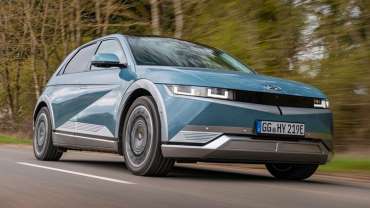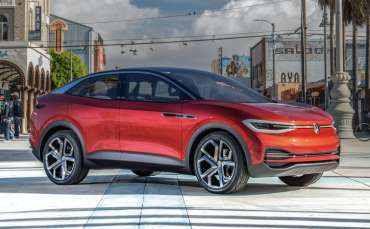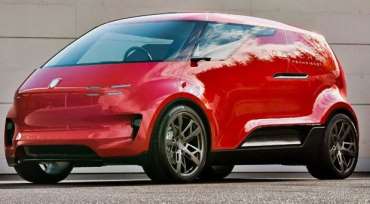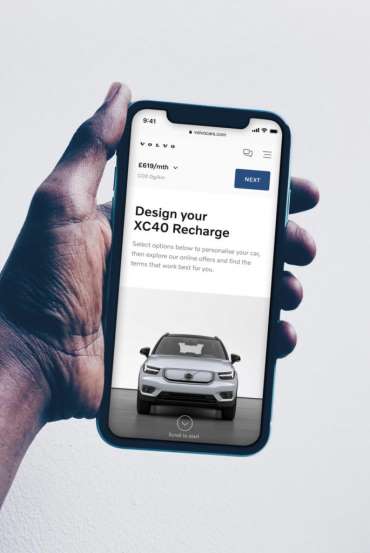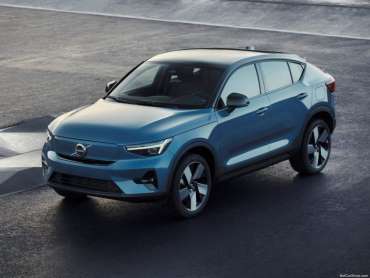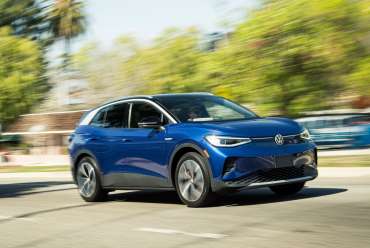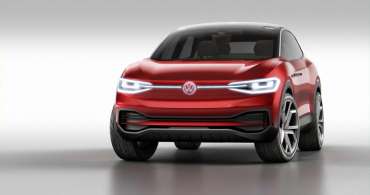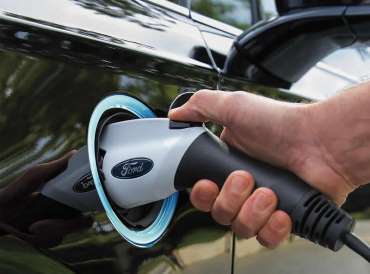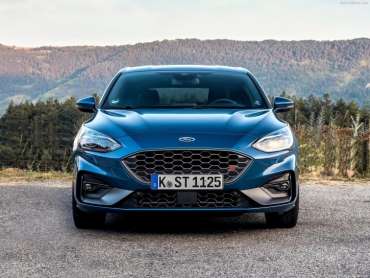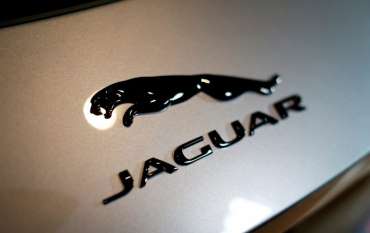Displaying items by tag: electric car
Hyundai Ioniq 5 prototype (2021) review: an electric showstopper
It's clear that Hyundai's mantra must be 'speak softly and carry a big stick.' It just must be. Being among quiet pioneers of family-friendly electric cars already with the original Ioniq and Kona, the brand is about to smack us across the chops with a whole new range of EVs under the Ioniq sub-brand, starting with this: the Ioniq 5.
We've driven a near-finished prototype of for our first whack. Has Hyundai beaten VW at its new game?
What a looker!
Hyundai says the look has been inspired by the Pony Coupe of the 70s but, unlike so many car brands looking to its past to guide its future, design-wise, this is no slavish pastiche. It's an eye-popping piece of design, shaped as a family hatch, with pixelated lighting front and rear and super-crisp lines.
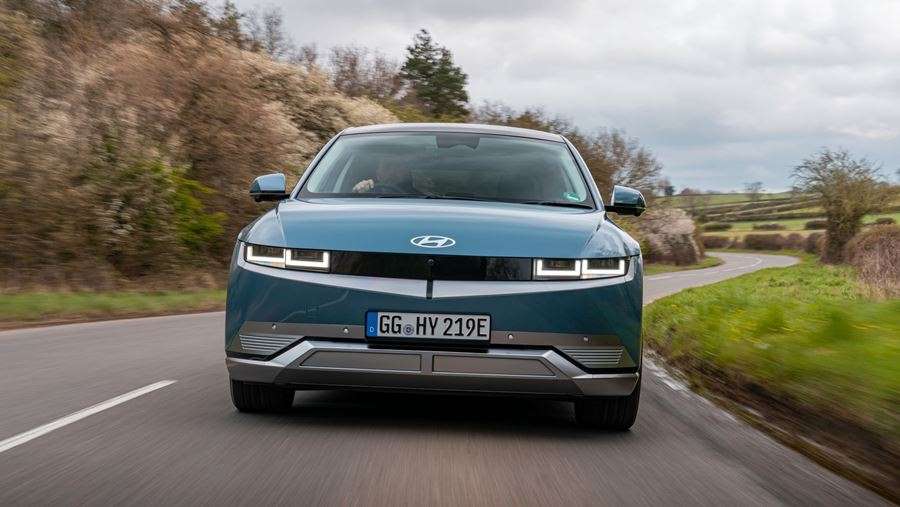
Interestingly, though, the Ioniq 5's dimensions are much larger than you think. This design masterstroke actually hides the car's size: it's actually longer than a VW ID.4 both physically and in terms of its wheelbase and about 40mm taller than a Jaguar i-Pace.
Speaking of the i-Pace and ID range, we conveniently managed to park next to Jag's EV and an ID.3 – both look instantly dated compared to this.
Inside, the cockpit takes full advantage of the e-GMP platform that lies underneath. A flat floor means no fixed centre tunnel, with a movable centre console that provides cupholders, cubbies and a wireless phone charger. You're also greeted by thick padded seats, two massive screens and a kitsch two-spoke wheel like a Honda E.
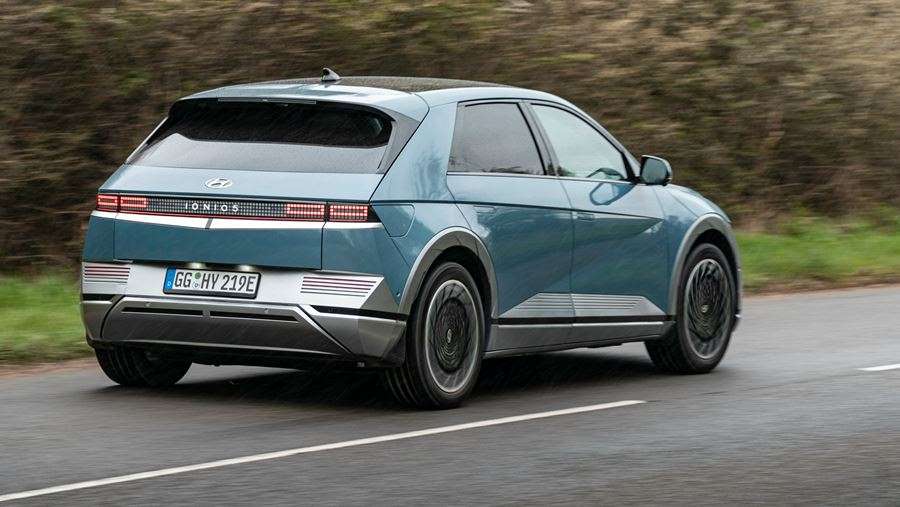
But Hyundai hasn't gone tech overload in here like Mercedes, or ultra-minimalist like a Tesla Model 3 – there's a balance between large, useful screens, touch panels and physical switchgear and solid materials on all your regular touch points. The shift stalk, for example, is on the steering column, with a chunky twist action and the door inlays – complete with eco-friendly paper inserts – all feel solid with a tactile thunk when you pull the door handles.
Space is impressive, too. The cabin itself feels huge once you're inside, with loads of room for rear passengers, too. The rear bench can slide forward and back and, even with a 6ft 2in driver like myself at the wheel, there's tonnes of legroom. The boot, however, is rather shallow, but has depth end to end, and properly usable width. You don't even need to store your cables here – there's a handy storage box under the bonnet for that.
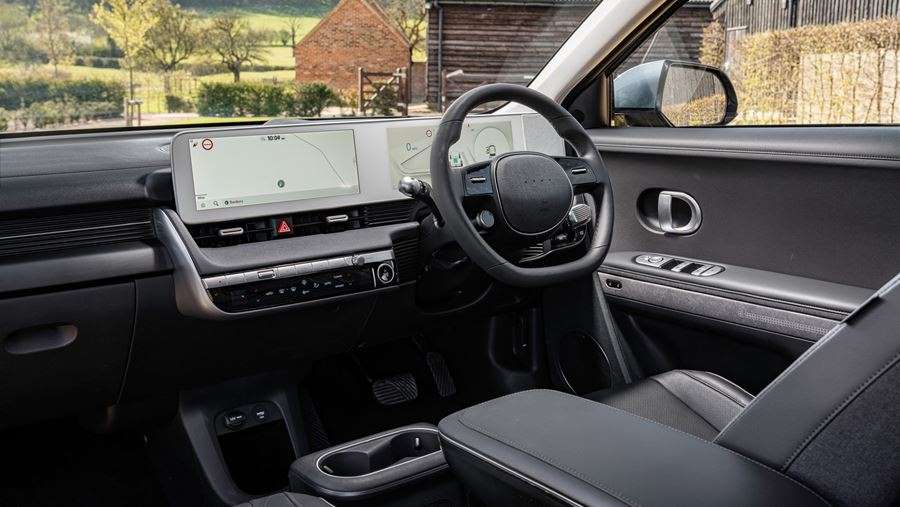
Any clever technology on the Ioniq 5?
The platform, for a start. The new e-GMP platform will underpin every new Ioniq sub-brand model from Hyundai along with Kia's new EV range starting with the EV6. Rear- and all-wheel drive powertrains are offered, with the Ioniq 5 giving you a choice of a standard range 58kWh or long-range 72.6kWh battery packs. And, along with a three-pin plug socket in the car, there's 'vehicle to load' – the ability to use the car as a rolling power bank, allowing you to plug in (via an adaptor on the charging port plug) almost anything externally, like a lawn mower, e-scooter or even another EV.
Hyundai's electric car plans explained
It's also as clever as a Taycan, allowing for both 400 or 800-volt charging, meaning (on the fastest available 350kW chargers, of course) the ability to zap from 10 to 80 per cent charge in just 18 minutes. Hyundai claims 296 miles in the Ioniq's thriftiest setting (larger battery, rear-wheel drive), but you can expect an ID.3 rivalling 260-plus from the all-wheel drive variant.
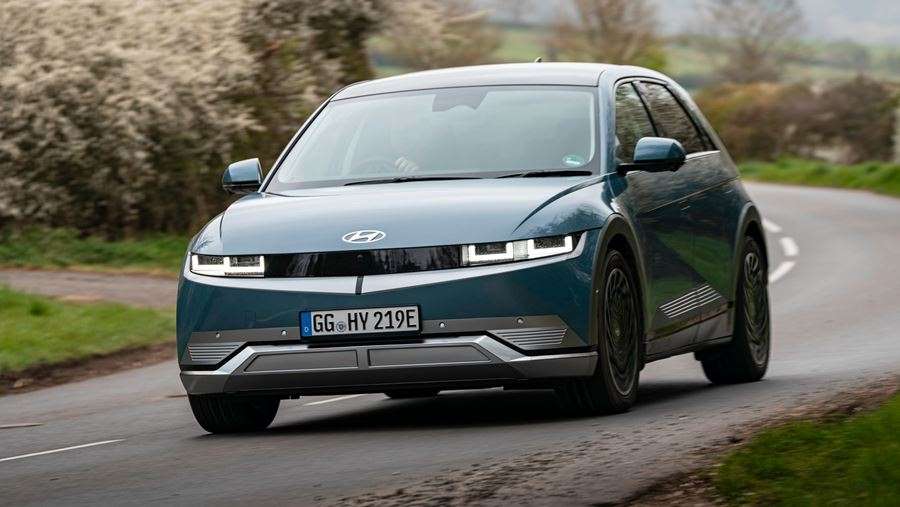
Live in a sunny area? Of course you don't, not in the UK at least, but you can spec a solar cell roof (after the Ioniq's initial launch) that aids the batteries: 'The solar roof has a charging capacity of 205W, and in an environment that is sunny we did some experiments and found that it could add 1200 miles of range per year, or about three miles per day,' Ioniq 5 project manager, Askin Kahraman, told us, 'The roof will also help the 12V battery so the car doesn't discharge completely.'
Then there's all the available tech on board. Along with Level 2.5 semi-autonomous driving tech, you can have Hyundai's Blind Spot View Monitor (that shows you the view of the door mirror camera when you flick the indicator), an augmented-reality head-up display and front seats that recline with leg supports like a living room La-Z-Boy.
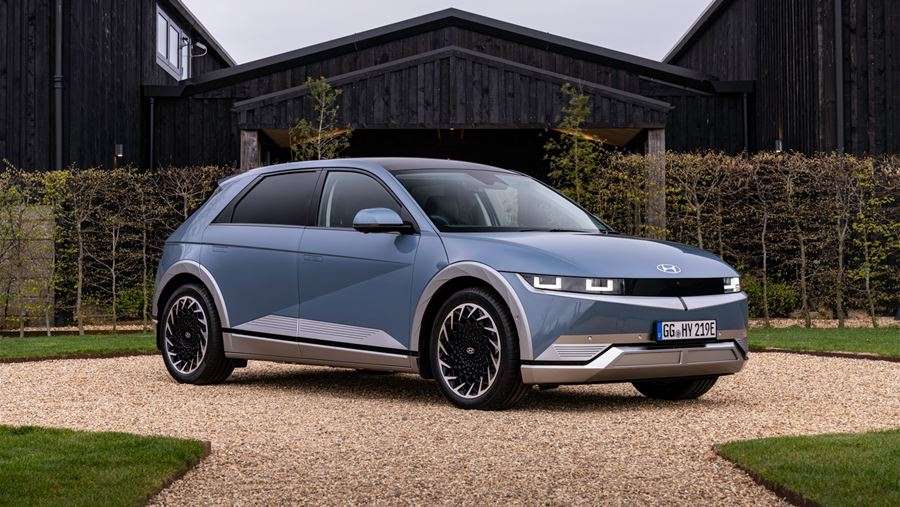
Hyundai's Blind Spot View Monitor: does it work?
Our car was fully trimmed with every frippery you could ask for, implying that it was one of the limited-run 'Project 45' versions, at £48k. On top of all the tech that gives you, it also means your Ioniq 5 comes with the bigger 72.6kWh battery and all-wheel drive. As for lower trims, we expect it to follow the same trim structure as Hyundai's other models: SE Connect, Premium and Ultimate, with the cheapest models circling the £39,000 mark.
Let's drive it!
Walk on up to it and flush doorhandles pop out, ready for the drive ahead. Given the front seat's reclining nature, the whole seat angles backward if you want thigh support – rather than just the front end of the base – and the wheel adjusts for plentiful reach and rake.
Once you're rolling, the 5's interesting details don't instantly reveal themselves – it feels entirely standard fare for a family EV – quiet, inoffensive and smooth when you're nipping around town. And properly quick, just like an EV with so much torque should be; Eco mode dulls the throttle while, at the other end of the drive mode scale, the dials glare red in Sport and the throttle response is incredible. And this simply won't be the most powerful version of the E-GMP platform, either. Kia, for example, has already shown off a supercar-baiting EV6 GT, so it's not beyond the realms of possibility that Hyundai could make an Ioniq N.
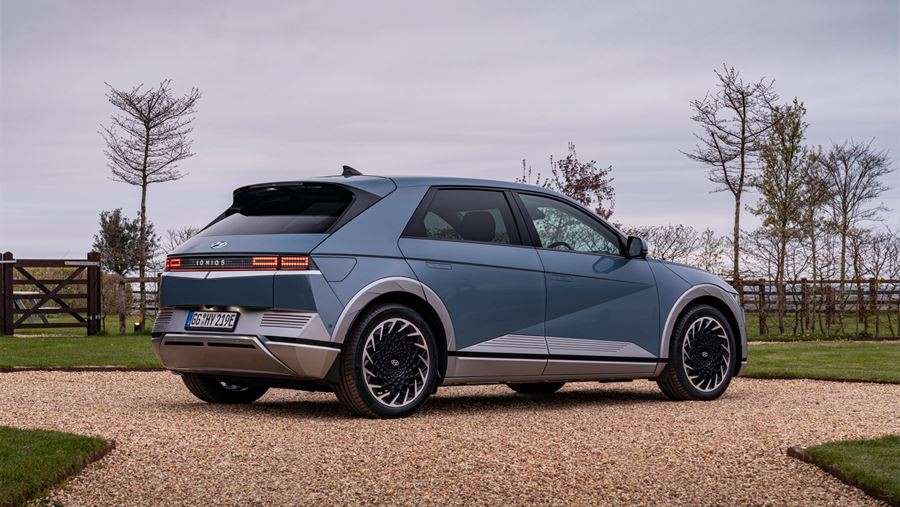
Then you start to notice the finer points after the miles roll on.
The steering, for example, is live-wire alert and well-weighted – no dead-spots off-centre and tremendously fluid when you wind the lock off after a turn. The turning circle is tight, too; not London Taxi or Honda E tight, but not far off. Then there's the brakes. It's almost an expectation for an electric car to have a soggy brake pedal and inconsistent feel when you apply some pressure due to regenerative braking (of which Hyundai has four steps, plus a one-pedal mode), but not here. Plenty of solid, accurate feel regardless of regeneration level.
You can really have fun with this car on a back road – something not often said this side of a Taycan. Adding up the whumping torque, sharp steering and feelsome brakes is already plenty good enough, but there's real balance to the chassis, too. This doesn't feel leaden or recalcitrant when you want some zippy thrills going the fun way home. Yes, there's a touch of body roll, but the way the suspension handles the Ioniq's weight is really something to be commended – it's a hoot.
We even got some time on the motorway. Hyundai told us that not all of the production-spec soundproofing is on this prototype but, if that's the case, I've driven plenty of family in-production family cars (including those of premium manufacturers like Audi) that riding on 20-inch wheels that have worse NVH refinement. Tyre noise is well within an acceptable level and wind noise is minor. Couple this with balanced ride quality – not too jittery, but not water bed wallowy either – and it's a very promising position to be in.
First impressions: Hyundai Ioniq 5
What an impressive machine. We can't wait to try a production-spec one but, even in this prototype, the Ioniq 5 brings such a breadth of abilities that other EVs can only dream of. Show-stopping looks, a thoroughly usable and appealing interior, and sharp dynamics that are rare to find in a heavy family EV.
Convinced by VW's ID.3? Try one of these first.
(carmagazine.co.uk)
VW came up with the name from its e-vehicle: It will be called the Voltswagen
Automotive giant Volkswagen will rename its electric vehicles in the US to ‘Voltswagen’. It has not yet been confirmed whether this will apply to vehicles sold in Europe.
The news allegedly briefly appeared on the American press page yesterday, but was soon removed. Volkswagen's PR, Brendan Bradley, did not comment on the allegations, but according to media reports, a source close to the company said it was a permanent change that would apply to VW in America and would clearly separate electric models from conventional ones.
Although not confirmed, the German brand is not expected to change the name of its e-vehicles in Europe either.
A USA Today reporter quoted part of an official announcement stating that the Voltswagen is more than a name change.
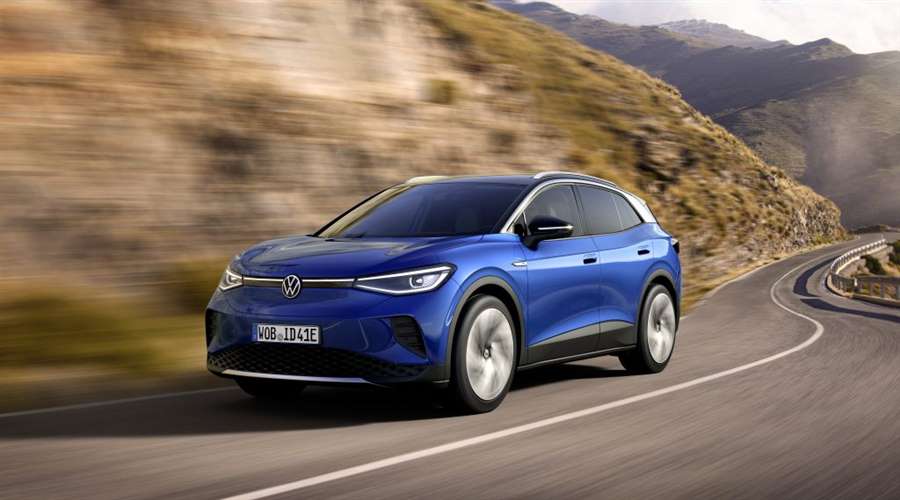
"It is a public declaration by which the company announces future investments in e-mobility," reads the statement.
According to that announcement, electric cars will get the inscription Voltswagen, while the others will keep the classic VW logo.
This news comes at a time when Volkswagen is starting to commercialize the ID.4 electric crossover, the first that could seriously change the power relations in the electric vehicle market in America, Index.hr reports.
Recall, VW has announced 70 electric models by 2029, as well as sales of one million electric cars by 2025.
Porsche has spoken out about the idea of an electric minivan
Porsche made Vision Renndienst back in 2018, and due to the popularization of electric cars, many wondered if a new surprise from Porsche would follow.
The answer was given by Porsche itself for Autoblog. They stated that the company will not embark on new excursions in terms of city cars, even if they look like a concept minivan.
Vision Renndienst
According to Index.hr, Porsche's head of global design Detlev von Platen stated that he would only participate where “it is possible to define a sports vehicle.” It is a pity because this concept would be interesting to see on the road.
Let us remind you, Renndienst was designed by Porsche in 2018, and it was shown to the public for the first time at the end of last year. The driving position is central, as in the McLaren F1, but it can carry six people.
Volvo from 2030 on electricity only. And the possibility of shopping only online
Don't use the Internet and have nowhere to charge your car? Forget Volvo.
Okay, if you don’t use the Internet, you won’t read anything new and you won’t have anything to regret. But Volvo is really turning its business around.
From 2030, every new Volvo will be electric
News has arrived from Sweden that Volvo Cars will be committed to becoming leaders in the fast-growing premium electric car market with a plan to become a fully electric car company by 2030.
Until then, the company will gradually phase out models with internal combustion engines, including hybrids. At Volvo, they expect that legal solutions and the expansion of charging networks will enable this transition to electric cars.
For now, Volvo will only sell its electric vehicles online.
Volvo Cars last year launched its first all-electric car, the XC40 Recharge, in markets around the world. In the coming years, Volvo Cars will introduce several additional electric models. By 2025, the goal is for 50 percent of global sales to consist of fully electric cars, and the rest will be hybrids. By 2030, every car he sells should be fully electric.
And the role of the merchant?
The fight for clients is over - there will be nothing to negotiate here. The buyer buys the car at the price shown on the website, and the seller must prepare it, elegantly hand it over and then service it. In the meantime, they may organize a test drive to help those who are not satisfied by clicking on the page. Volvo emphasizes that the dealer network will be just as important as it is today, but the role of dealers will be limited because electric cars are much simpler. We wonder what interest the owners of car dealerships will have in this approach of the manufacturer?
The new electric Volvo and the announcement of the end for petrol and diesel
After Jaguar Land Rover, Bentley, GM, Ford and others, Volvo has now announced that from 2030 it will produce exclusively electric cars. That's why they accelerated a bit, so today the second electric model of the company was shown - C40 Recharge.
Moreover, the Swedish brand plans that from 2025, half of the sold Volvo cars will be powered by electricity, and the other half by hybrid drive.
This means that in just four years, they will stop selling models powered exclusively by SUS petrol or diesel engines. And whoever decides to buy a new Volvo in ten years, the only models that will be available will be electric.
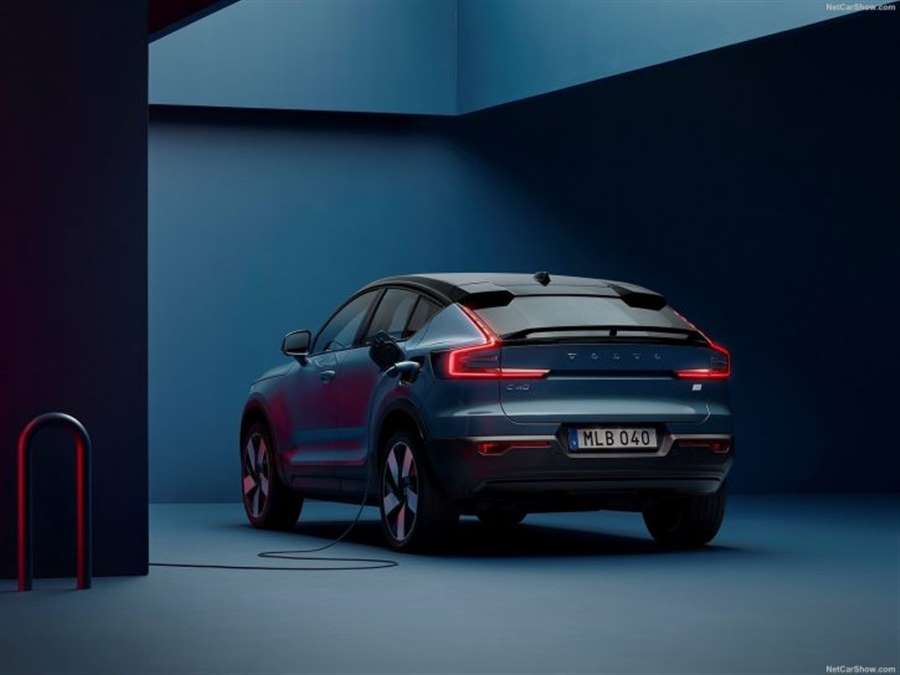
Volvo is owned by the Chinese company Geely, from which it has been confirmed that the conventionally powered models will be on sale only for a while longer, all in order to meet the stricter standards on harmful gas emissions, writes CNN.
It will be a very difficult task for a company that literally has 2 electric cars as of today - the famous XC40 Recharge and the C40 Recharge introduced today.
The new coupe-SUV is based on the XC40 Recharge model, but is slightly lower than it. In addition to a more attractive design, it also has two powerful electric motors with a total power of 408 hp. The 78 kWh battery provides a range of about 420 km, and a charging time of up to 80% is 40 minutes. The new electric model will cost just over £ 50,000.
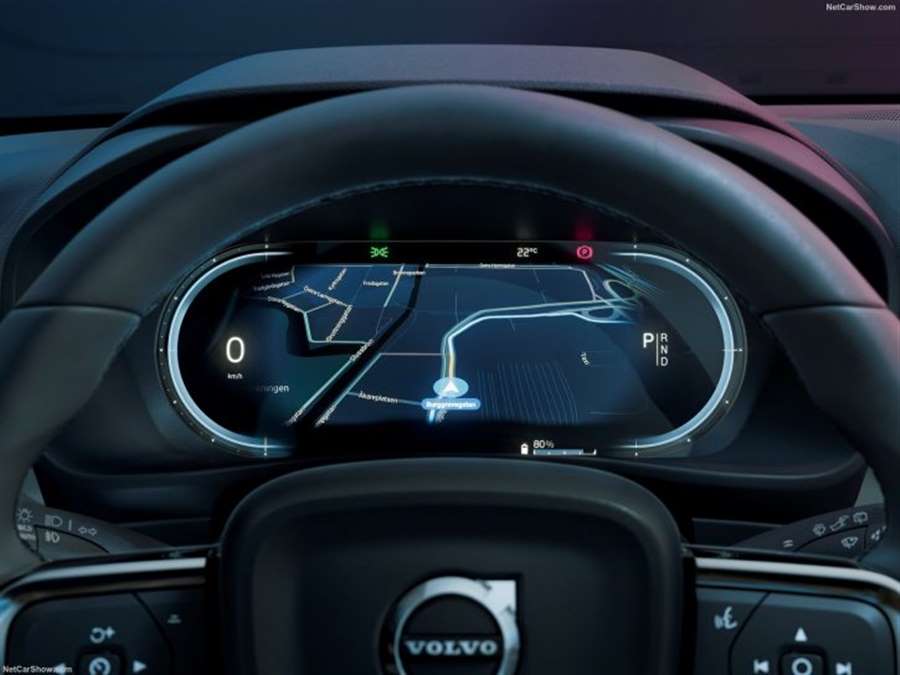
The head of Volvo announced that in addition to the new electric model from the 40 series, more novelties will arrive in the years ahead. As they pointed out from the Sino-Swedish company, they will work a lot on the development of the autonomous driving system.
Another interesting fact that they made public is that the new electric Volvo cars will be sold exclusively online, which already applies to the new C40 Recharge. Investing in online sales will further reduce costs, and after all, a similar strategy is being implemented by Tesla, whose models are officially sold exclusively online.
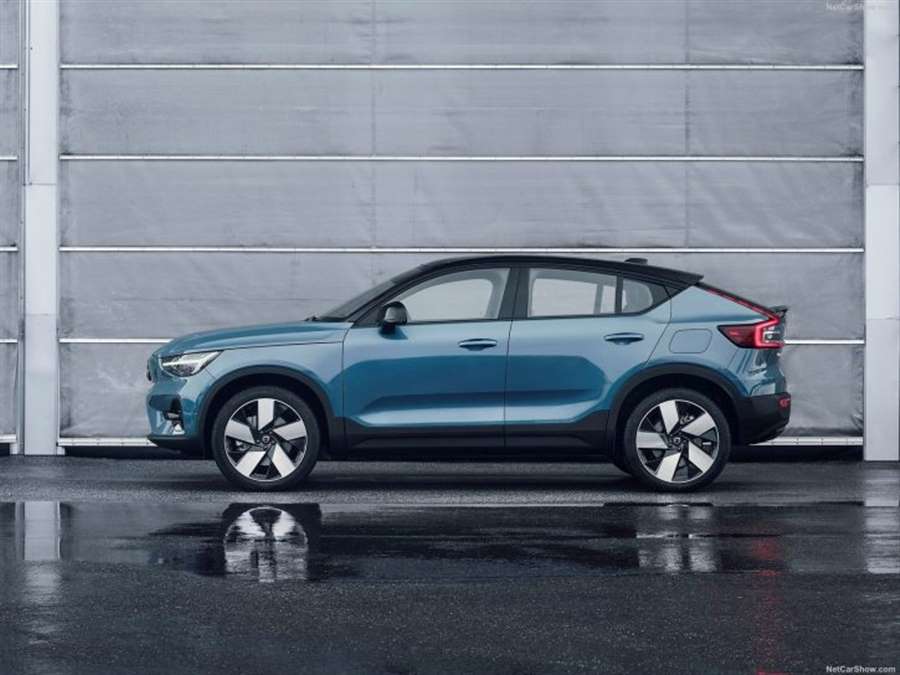
We remind you that many other car companies have recently started announcing plans for a significant acceleration towards full electrification of the market in Europe.
Among them are Daimler, Ford (which will cooperate with VW), JLR and others, while Tesla's first factory in the EU, which is being built in Berlin, will also contribute to this trend.
Also, it is expected that the production of electric cars will be cheaper compared to conventional ones, both due to the new generations of batteries and the smaller number of parts that would be transported and, therefore, the smaller number of workers needed for assembly.
Tested: 2021 Volkswagen ID.4 Seeks to Normalize Electric Cars
VW's electric crossover succeeds at imitating the gas-powered competition but forgoes many of the things we like about EVs.
As electric cars begin to proliferate, we are seeing the auto industry figuring out the best way to build and sell battery-powered cars. Some take existing gasoline models, rip out their powertrains, and bolt in battery packs and electric motors. A few existing carmakers have started new EV-only brands to market purpose-built electrics. One brand is courting the attention and controversy that comes from putting a famous pony-car nameplate on an electric car. And then there are the startups whose big promises are only outdone by the cultlike devotion of their fans. Against this backdrop, VW's approach for the new ID.4 looks extremely logical and straightforward. The 2021 ID.4 is designed and engineered to be an electric crossover that matches the specifications, performance, and character of the best-selling gas vehicles in the United States: compact SUVs such as the Toyota RAV4 and Honda CR-V.
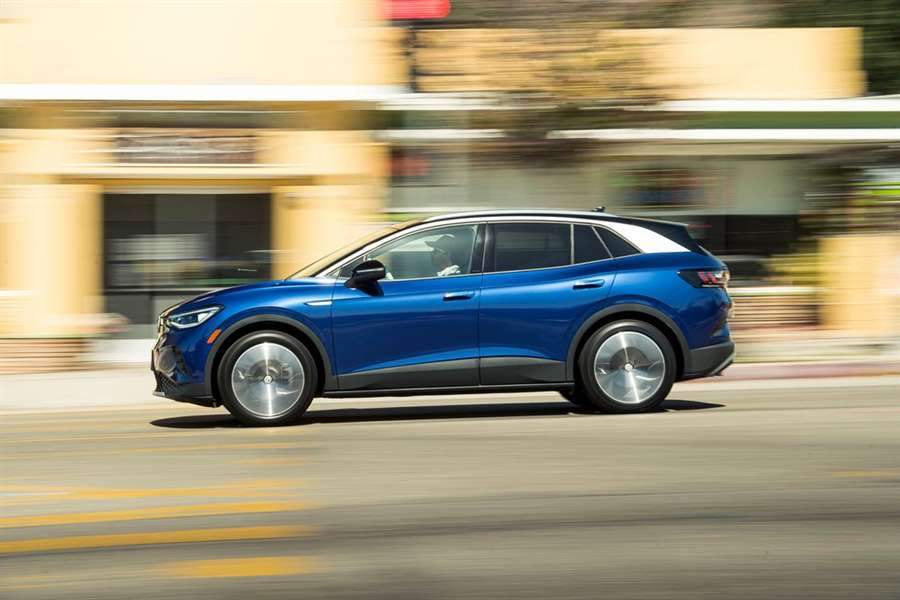
Built on the VW Group's new MEB modular EV platform, the ID.4 has a 77.0-kWh lithium-ion battery pack under the floor and a 201-hp electric motor on the rear axle. While this layout is unusual for the compact crossover-SUV segment, the ID.4's dimensions make it a lot like the rest of the class. The VW's wheelbase is longer, but its length and width are within fractions of an inch of the RAV4's. The ID.4's design hardly advertises its electricness and isn't any more eye-catching than your average crossover. It's shaped like a two-box blob with conventional-looking headlights and taillights. The only bits of flair are in the grilleless face and the optional contrasting C-pillar trim.
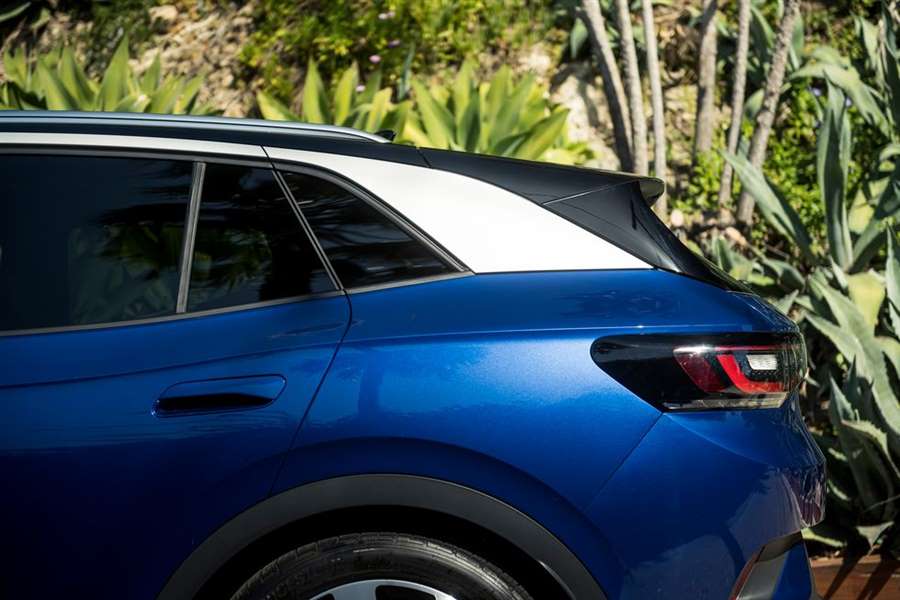
HIGHS: Spacious interior, comfortable ride, quiet at speed.
The ID.4's primary controls are set up to mimic the experience of a gas-powered car. Sit down, turn a knob to put it in Drive, and you won't have to make any adjustments to your driving behavior. Let your foot off the brake and it creeps forward just like a gas car with a torque-converter automatic transmission. Lift off the accelerator and it continues to coast like a gas car with an automatic.
To get more braking from the electric motors requires putting the car into its "B" setting, but even in that mode the regenerative braking effect isn't aggressive enough to reliably slow the car with a lift off the accelerator or to bring the ID.4 to a complete stop. Volkswagen promises one-pedal driving in B mode, but our regular use of the brake pedal had us questioning the brand's definition of the term.
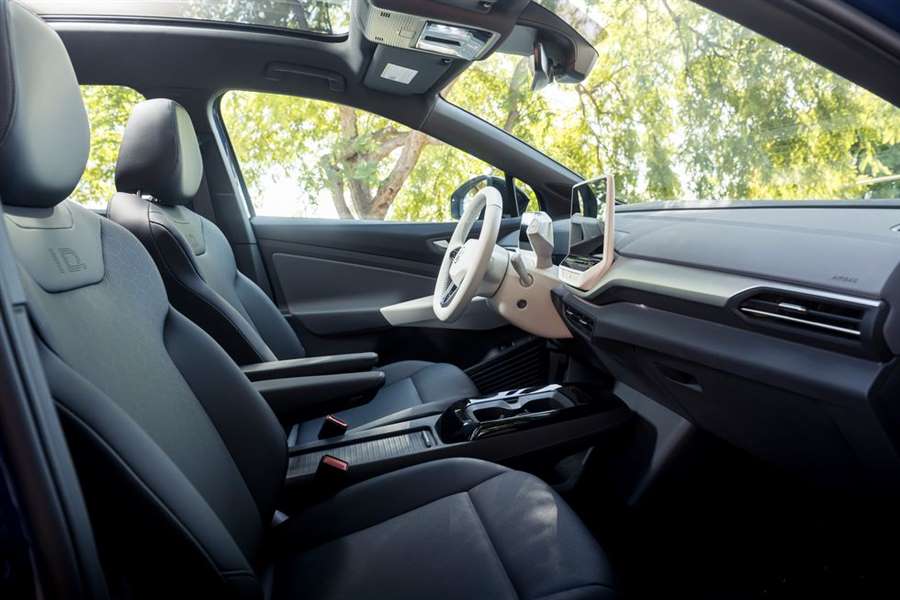
VW also touts ID.4's 201-hp electric motor as having about the same power as the base four-cylinder engines in many compact crossovers. Maybe so, but the ID.4 weighs 4698 pounds. That's a whopping 1000 pounds more than the gas-powered competition. With only 229 pound-feet of torque, the neck-snapping shove of instant torque we like so much in electric cars is largely missing. When merging or passing at highway speeds, the ID.4 feels sluggish. The run to 60 mph takes 7.6 seconds, and the quarter mile is complete in 16.0 seconds at 86 mph, on par with the quicker gasoline models in this segment but significantly slower than similarly sized EVs such as the Ford Mustang Mach-E and Tesla Model Y. A more powerful dual-motor all-wheel-drive version of the ID.4 with around 300 horsepower will be available later this year and will likely bring the ID.4 closer to the snappy acceleration of other EVs.
LOWS: Unexciting to drive, anonymous styling, annoying infotainment.
If you are excited about the handling prospects of this rear-drive configuration, don't be. The ride is pleasingly firm and the steering is appropriately weighted, but there's little verve or joy to the driving dynamics. The ID.4 simply goes where it's pointed without complaining, which, to be fair, is what's expected of a small SUV. We recorded 0.85 g of grip on the skidpad and a stopping distance of 166 feet from 70 mph, average numbers for the class.
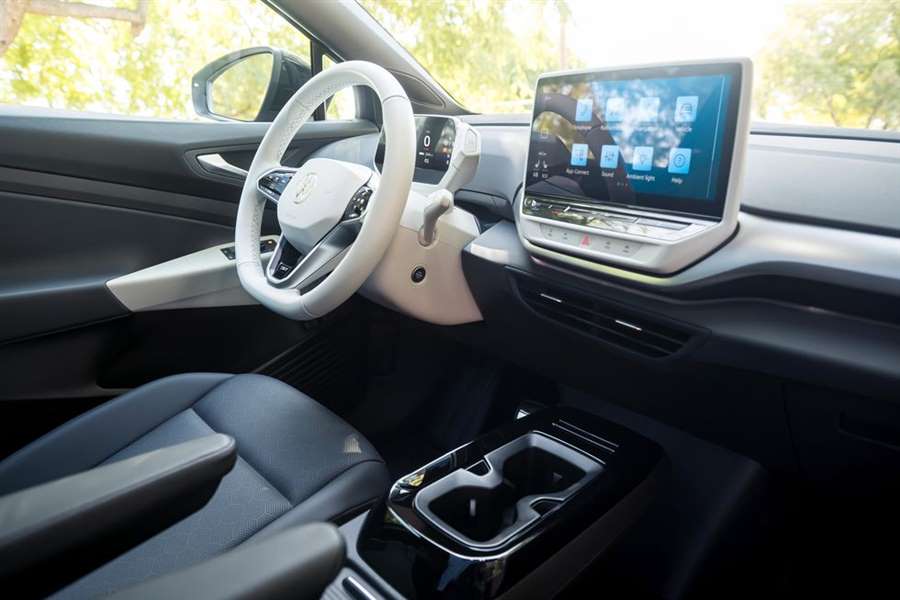
Driving the ID.4 is a largely serene experience. At 70 mph we measured a library-like 68 decibels, and the powertrain remains hushed under acceleration. The interior is airy and spacious, with a low beltline and a generous rear seat. There's no "frunk" as in many other EVs, but the cargo area behind the hatch is big, fitting eight carry-on suitcases with the rear seats up and 26 cases with the seats folded. The front seats are good for hours, and the driving position is natural, with good visibility. Storage cubbies abound, and rear-seat passengers enjoy their own USB ports and air vents.
The least conventional aspect of the ID.4 is the one you'd most hope to follow convention: the user interface. We're not fans of VW's latest infotainment software, which is overly reliant on the 12.0-inch touchscreen and doesn't provide enough physical controls for things you want quick access to such as heated seats and radio tuning. There are touch-sensitive sliders for the climate controls, sunshade, and volume adjustment, and haptic buttons for various menus. Even the few physical controls are strange. There are only two window controls on the driver's door panel, and you must press a finicky haptic switch to activate the rear windows. And the clean look of the white steering wheel isn't going to stay clean for long.
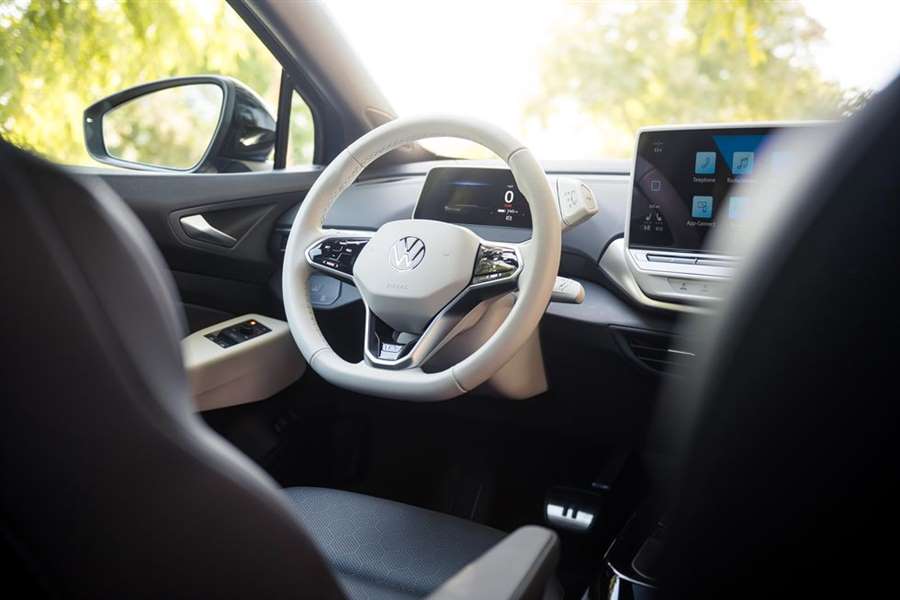
The driving experience in the ID.4 is so normal that it's easy to forget that there's nothing for you at a gas station except Flaming Hot Cheetos. The EPA claims a 250-mile range in combined driving, and we measured 190 miles in our real-world 75-mph highway range test done just above freezing temperatures. (Cold temps negatively impact battery range.) Refilling the VW's battery from empty takes about 7.5 hours on a typical 220V charger, and fast chargers can get you from 5 to 80 percent charge in a claimed 38 minutes. Thanks to Dieselgate, VW is investing heavily in charging infrastructure through its subsidiary, Electrify America. Buyers benefit from the scandal with three years of free charging from Electrify America's fast chargers.
Early adopters of new tech might be disappointed by the ID.4's lack of quirkiness. The ID.4 feels like it's trying to convince buyers that an EV can cost and provide the same experience as mainstream gas-powered vehicles. Pricing starts at $41,190, and our 1st Edition test car stickered for $45,190, which is within reach of loaded gas-powered compact crossovers, especially when you factor in thousands of dollars in federal tax credits.
Rather than an electric vehicle shaped like a compact SUV, this Volkswagen feels like a mainstream crossover that happens to have an electric motor and a battery pack. But the ID.4 lacks any distinct advantages over gas models, and it's missing the cool factor and instant-feeling acceleration of other EVs. VW is so determined to make the ID.4 normal that it seems to have forgotten that EVs can be weird, funky, and fun. The ID.4 is a quiet and comfortable transportation pod that will satisfy buyers looking for a quiet and comfortable transportation pod.
Volkswagen started producing another electric SUV: ID.5
Production of the first pre-series copies of ID.5 has begun, while the start of production of models intended for the market is expected in the second half of the year. The new model should be reminiscent of the ID.Crozz concept, and it is certainly a coupe version of the already known Volkswagen electric SUV - ID.4.
The German car giant Volkswagen continues with the offensive on the electric car market, so it has already started the production of the third electric model based on the MEB platform, reports zimo.dnevnik.hr.
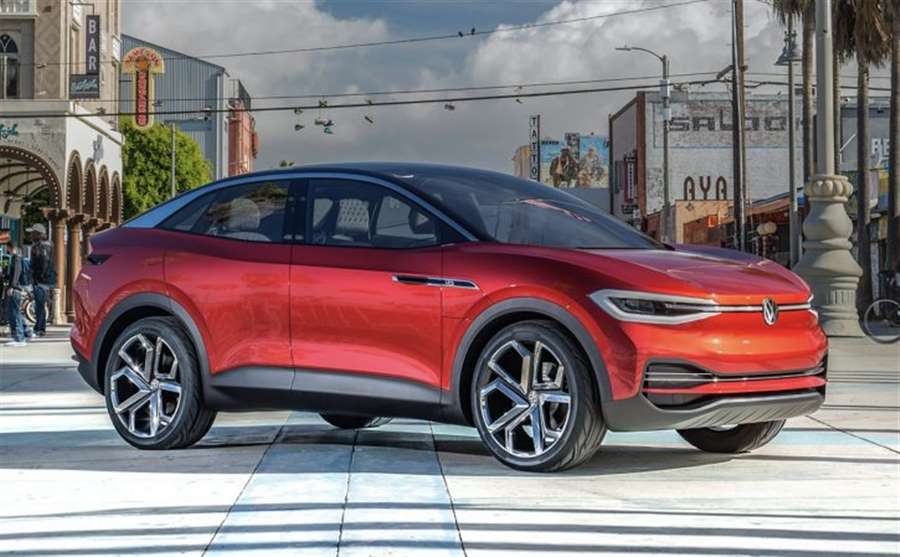
Sales of the ID.3 model (which should play the role of an electric Golf on the market) began last year, followed by the compact ID.4 SUV. Several other models are in preparation, such as the family ID.6, whose photos were recently leaked in China, and which you can see here, and ID.2 is mentioned. However, the first comes next - ID.5, an attractive SUV in the form of a coupe.
As ID.5 is not yet official, there is no data on its performance, but according to rumors, this will be a coupe version of the ID.4 model, which should look like the ID Crozz concept.
Although it has not been officially presented yet, the German company confirmed that the production of pre-series models has already started, while the production of the final versions is expected in the second half of the year.
Interestingly, like the ID.3 model, the "five" will not be intended for the United States, but the primary market will be European.
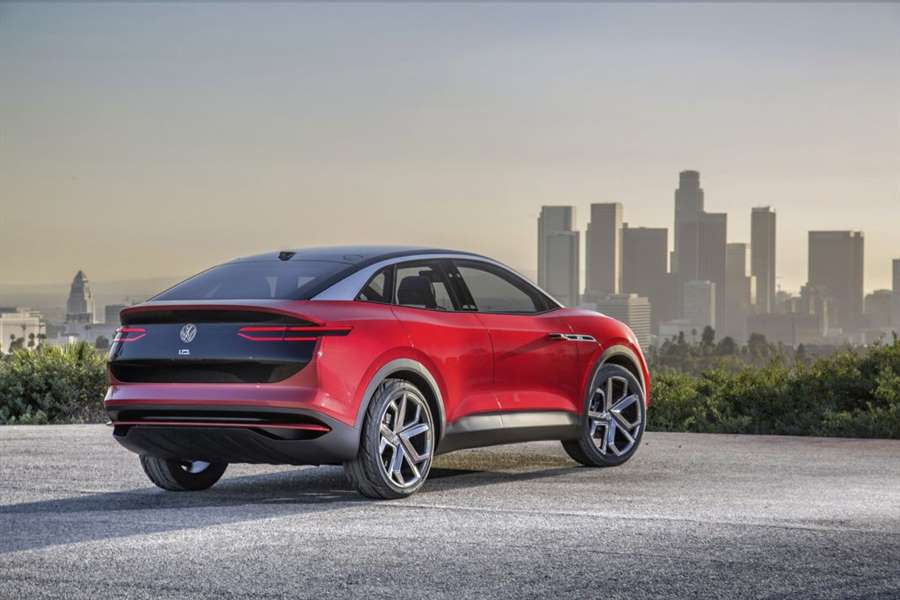
In terms of options and performance, it is speculated that the figures will be similar to those on the ID.4 model. Thus, the 150 kW engine that drives the rear wheels is mentioned (versions with two engines and all-wheel drive will appear later), as well as the 77 kWh battery.
Given that the start of production is expected in the second half of 2021, it is clear that Volkswagen will not wait too long until the official presentation of this model.
Pictures of the concept on which ID.5 is supposedly based indicate that this may be the most attractive electric "Volkswagen" which, if the price is not too high, could really achieve great market success, and perhaps be a bestseller in the e-SUV class. German companies.
Ford is building a new electric car on Volkswagen's platforms
Ford has announced that it will build a new electric car in Europe using Volkswagen's mechanical frame - a platform for battery-powered vehicles, and that it will spend $ 1 billion on rebuilding a factory in Germany to produce zero-emission cars.
Ford of Europe President Stuart Rowley told reporters that the factory in Cologne will build one model of electric passenger vehicle, which would enter the market in the middle of 2023, and it is possible that another model will be produced there.
He said it was part of Ford’s efforts to offer fully electric or gas-electric versions of all passenger vehicles in Europe by 2024, and all will be fully electric by 2030. The company predicts that by 2030, two-thirds of its commercial vehicle sales will be vehicles in Europe be electric or hybrid.
The agreement with Volkswagen, which allows the use of the mechanical framework of that German electric car company, known by the German abbreviation MEB (modular electric tool set), allows Ford to take advantage of Volkswagen's huge investments in electric cars, while the entire industry is shifting to zero-emission vehicles. pollution.
The Volkswagen platform uses standard mechanical bases such as the battery, wheels and axles, which can be adapted to produce different vehicle models.
Carmakers in Europe must sell more electric vehicles to meet new, lower emission limits for carbon dioxide, the main gas that causes global warming. If manufacturers do not keep the average emissions of their entire fleet below the limit, they will pay large fines. Rowley said Ford can avoid fines.
The company said that commercial vehicles are the key to growth and profitability in Europe, with new products and services through an alliance with Volkswagen and a joint venture between Ford and Otosan in Turkey.
The announced investment, which will be made by 2025, is among Ford's most significant for more than a generation and "underscores our commitment to Europe and the modern future," Rowley said.
Ford said that the investment in the factory in Cologne, with more than 4,000 workers, is starting after Ford's European operations returned to profit in the fourth quarter of 2020.
That investment is part of Ford’s goal to spend at least $ 22 billion on electric vehicles from 2016 to 2025.
And Ford is becoming an electric brand: It will cooperate with Volkswagen
The acceleration has begun and from now on we will hear almost daily news about which car brand is becoming fully electric in the period ahead. After Mercedes, Jaguar Land Rover, Bentley and many others, Ford has now stated that from 2030 it will offer exclusively electric models in Europe, as well as that the first European Ford on electricity will be made on the VW platform.
According to the promise from Ford, by the middle of 2026, every model on the European market will be available as a plug-in hybrid or electric, and by 2030, this company will switch exclusively to electricity.
Full electrification refers to passenger models, while commercial vehicles will have zero emissions by 2024.
All this fits in with the announcements from numerous European countries that they will ban the sale of gasoline and diesel engines by 2030, among which the United Kingdom is in the lead.
That is why Honda, Volvo, Nissan and others have announced that they will not even offer models with conventional drive in Europe. Honda will start implementing this plan as early as next year.
As for Ford, they are investing a billion dollars in the renovation of the factory in Cologne, where the production of the first European fully electric model will begin in 2023.
It will use Volkswagen's MEB platform on which the ID.3 and ID.4 models are created, and the first EV model from Ford made in Europe will be produced in parallel with the Fiesta. More information will be revealed in the coming period.
From 2025, the Jaguar becomes a fully electric car
The famous luxury car Jaguar will become 100% electric from 2025, announced the British manufacturer Jaguar Land Rover, which presented its new "green" strategy.
The company, which belongs to India’s Tata Motors, has expressed a desire to introduce some innovations under the leadership of a new CEO, Frenchman Thierry Bollore.
The British company has promised to invest 2.5 billion pounds (2.8 billion euros) annually, mainly for electricity.
"By the middle of the decade, Jaguar will experience a renaissance so that we have a purely electric luxury brand," the company stated.

